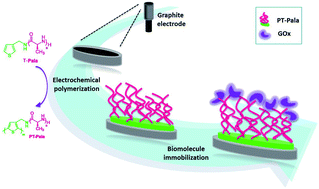In this article, Endo, Timur, Yagci and co-workers reported on a simple and efficient approach for the electrochemical deposition of polypeptides as bio-based covering materials for surface design. The method involves N-carboxyanhydride (NCA) ring-opening polymerization from its precursor to form a thiophene-functionalized polypeptide macromonomer (T-Pala), followed by electropolymerization. The obtained conducting polymer, namely polythiophene-g-polyalanine (PT-Pala), was characterized and utilized as a matrix for biomolecule attachment. The biosensing applicability of PT-Pala was also investigated by using glucose oxidase (GOx) as a model enzyme to detect glucose. Finally, the antimicrobial activities of newly synthesized T-Pala and PT-Pala were also evaluated. Interestingly, this technique is experimentally facile and can be applied to various types of polypeptides.
Electrochemical deposition of polypeptides: bio-based covering materials for surface design by Huseyin Akbulut, Murat Yavuz, Emine Guler, Dilek Odaci Demirkol, Takeshi Endo, Shuhei Yamada, Suna Timur and Yusuf Yagci, Polym. Chem. 2014, 5, 3929-3936.
Julien Nicolas is a web-writer and advisory board member for Polymer Chemistry. He currently works at Univ. Paris-Sud (FR) as a CNRS researcher.











